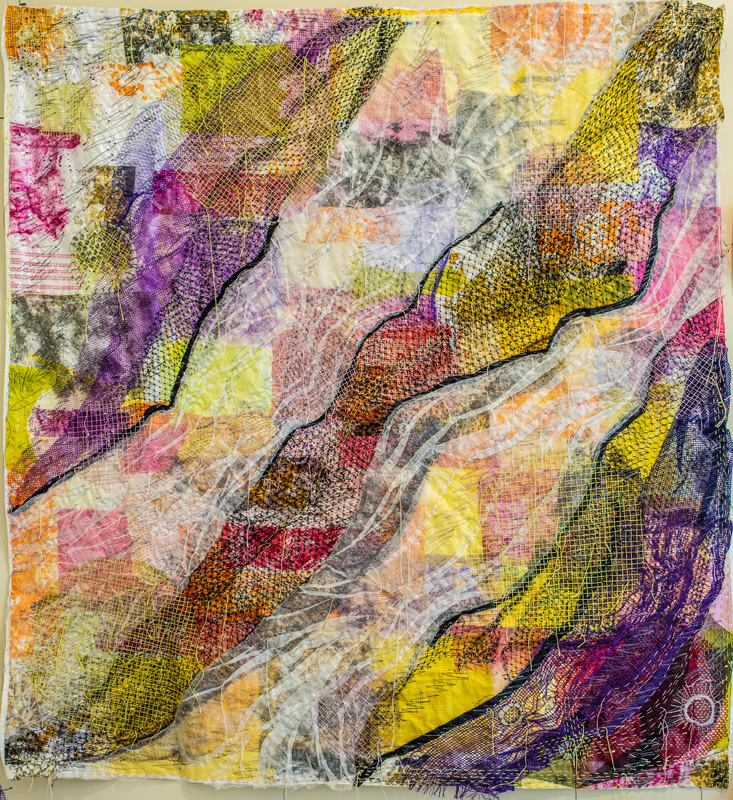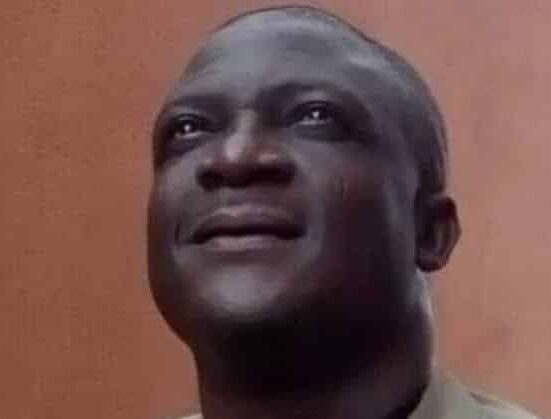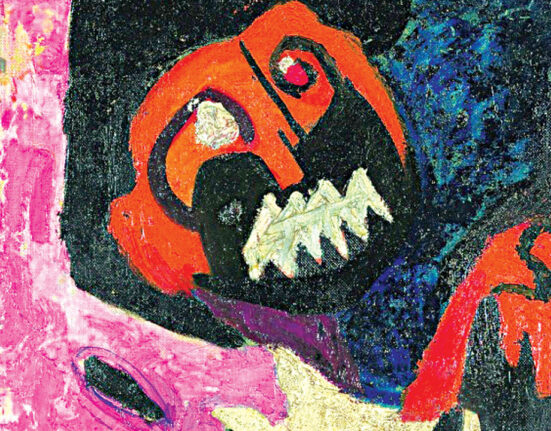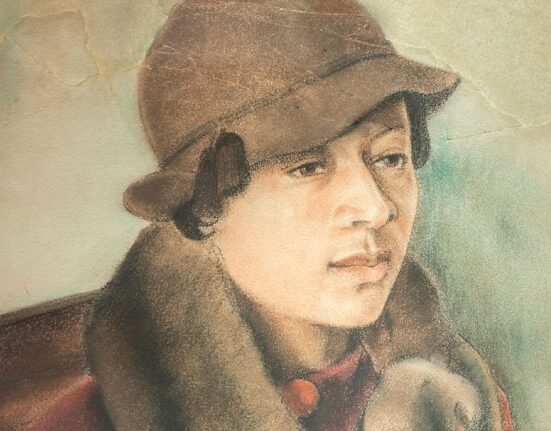Ingenuity threads throughout Featherstone Center for the Arts’ new exhibition “Rising Up! A Multi-Cultural Celebration of Stitched Fine Art.”
Put the idea of a quilt show out of your head. The artwork in “Rising Up!” intriguingly pushes boundaries of subject matter, from figurative to abstract, materials, scrim to plastics, and dimensionality, with some works physically moving off the wall into our space.
Referring to the show’s title, Vineyarder, curator, and artist Michele Beasley Maloney says, “For one thing, it’s about raising people’s understanding about stitch as a mark maker, as a structural element, and as a legitimate art medium.” The artists use it both decoratively and to hold things in place. She continues, “The show accidentally became all women, and half are people of color. We are ‘raising up’ people’s understanding of these women as fine artists and these types of work as fine art.”
The show teems with multiple pieces from each artist, reflecting the diverse range of each creator.
We encounter Chiaki Dosho’s exquisite “Cherry Blossoms 10” before entering the gallery. She constructed the enormous three-part piece by cutting and then sewing down multiple layers of small, feathered “petals” of vintage silk kimono peppered with specks of red fabric, and adding string and yarn that allude to the title.
L’Merchie Frazier says, “I remember, reclaim, and reimagine history to create restorative narratives of Black and indigenous people in the U.S. and globally … My art reveals spaces occupied by people searching for justice, freedom, and equity.” She builds striking portraits in “The Mathematics of Racism”: “Living in the Calculus” series with multiple layers of organza. Microscopic pieces animate the faces, which gaze straight into our souls. Frazier’s patchwork of synthetic cautionary tape emblazoned with that word in English and Spanish speaks of having to continually “calculate” where they will be safe in the world.
Susan Lenz says, “I regard artmaking as a conversation with viewers and a catalyst for diverse dialogue.” In “Rococo Diptych,” she quilts a verdant garden in delicate washes of predominantly blues, greens, and yellows, as though drawing with ink. Sealing it with a thick layer of transparent resin creates a translucent, luminous surface that draws us in to see the skill and beauty of her work.
Jaleeca Yancy is committed to sustainability, and experiments with materials of liberation and healing. The indigo dye she makes and uses in her large hanging installation in “Hant Blue Wave” resonates with ancestral meaning. Yancy reclaims her heritage using indigo, which originated in Africa, and which enslaved peoples were forced to grow. “My creative practice fosters connections, provokes thought, and inspires action toward a more inclusive, sustainable future,” Yancy states.
Linda Syverson Guild identifies as an architect who builds in fabric, with a particular fondness for incorporating scraps from earlier projects for new pieces, imbuing the work with freshness. While abstract, the title in “Points of Entrée” gives poetic meaning to the physical keys she attaches to her geometric fabric patterns that coalesce into textural composition in related shades of brown and beige, accented with black, white, and warm specks of color.
Shin-hee Chin stitches painterly works whose intricacy is mesmerizing. She builds naturescapes such as “Lake Autumn,” stitching coarse thread in layer after layer to create dense “canvases” that entirely obscure the underlying fabric.
Working improvisationally, Pamela Flam hand-stitched her impressive, joyously colored quilt, “The Healing Snake.” With exuberant color and written messages, Flam’s appealing snake urges us to shed our skin — whatever no longer serves us. The creature even sports a pocket around its neck for us to slip in a small piece of paper, naming something we wish to get rid of.
In Alice Beasley’s irregularly shaped “Why Am I Not Where You Are,” a bare-chested, trousered Black man swims upward amid a patched watery blue background. The narrative is left up to us about what he is swimming from or toward. Beasley shares, “I find color, light, shadow, line, and value in the pattern of ordinary household fabrics. As such, the work grows from within rather than being applied to the surface of a canvas by paint, pencil, or similar drawing tools.”
Natalya Khorover creates beauty from discarded items. “Striving to lessen plastic pollution and overconsumption drives my creativity,” she explains. Khorover collects single-use plastic food packaging, transforming it through stitching and collage. Her stitched markmaking in “Meditations” transforms the suspended clear, plastic musical drumheads into translucent circles of light and color: “My mission is to make these materials unrecognizable, enticing viewers to look at something they would otherwise avoid.”
Paula Kovarik says that stitch is her second language. “I look for the uncanny in life, things that don’t make sense,” she says. Gazing over her long work, “You Are Here,” we are left wondering where “here” might actually be. With ink, thread, and color, she seems to conjure up a terrestrial landscape that is strange and enticing, but out of reach.
Earamichia Brown’s stunning “Afro-Futura” series imagines a black woman arriving and ultimately thriving in a world free from bias and filled with love and peace. Brown begins by digitally painting the visionary, bold portraits, adding immensely intricate stitching that enhances their visual complexity.
Sharon Havelka’s three-dimensional “Vessels” beckons us to sit within it, cocooned in the beauty of her quilting. She explains, “The history and experiences of my Mississippi Chinese family are deep in the unique, threadbare fabrics I use: my grandmother’s treasure trove of upholstery and dress material is carefully pieced with my husband’s worn pants, our children’s old clothes.”
Wen Redmond veils her original manipulated photograph under two layers of free-floating organza in “Beyond the Abbey Window,” creating a sacred air. The central image is stitched on top of layers made of vintage book pages and other materials, building up an intriguing surface.
Karol Kusmaul’s “Mugshot” is a mesmerizing feat of quilting. The work’s title increases the pathos for the anonymous woman whose countenance of deep pain strikes our hearts. “Interesting people are everywhere,” she says, “and each one has numerous stories to share.”
Caroline MacMoran’s eclectic collection is comprised of mundane household fabrics and found items. For her, “The surviving traces become ethereal objects of persistence, endurance, and perseverance. I am interested in how material signals place.”
Beasley Maloney says of her painterly “Island Roots,” “This is how I started to feel when I decided to live here permanently. It was also the first time I started using plastics.” The grove of trees root in the found homemade fabric with mystical orbs ethereally floating above. The accents of manufactured plastic contradictorily add an alluring texture and sheen to nature’s arresting beauty.
“Rising Up!” is gloriously eclectic. But what binds the artists together is their imaginative spirit in pushing the frontiers of the stitched tradition to create something marvelously new. Beasley Maloney reflects, “What is considered art moves all the time, and I wanted to help people see that.”
“Rising Up! A Multi-Cultural Celebration of Stitched Fine Art” is on view at Featherstone Center for the Arts through July 21.







